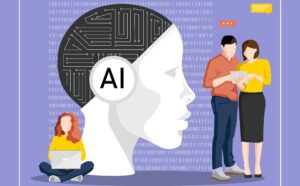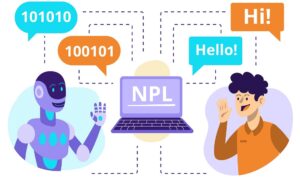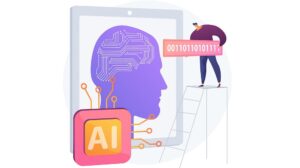What is a Large Language Model (LLM)?
What is a Large Language Model (LLM)? : Large Language Models (LLM) are not just advanced artificial intelligence systems, but they represent a significant leap in AI capabilities. These models, developed based on deep neural network architectures, especially transformer models, can understand meaning, answer questions, generate text, translate languages, and even summarize information. Their applications, such as improving search systems, customer service support, content production, and intelligent assistants, highlight their crucial role in today’s modern world. A large language model is not just an AI-based deep learning algorithm, but a game-changer that can understand and respond to various texts and data based on the massive amount of data it receives.
What is large language model or LLM?
A large language model or LLM stands for a Large Language Model. A language model is a machine learning model that can understand and produce texts like humans. The structure of a large language model is derived from the human brain, so these models work similarly to neurons and nerve cells. These models use deep learning machine learning to understand the connections between components. This type of learning allows the model to examine and discover complex patterns and relationships among new data by analyzing the data it receives. Large language models have broad applications. Using these models, various activities, such as natural language processing, text translation, image recognition, data processing, etc., can be performed with incredible speed and accuracy.
History of Language Models
The journey of creating artificial intelligence that can understand human language and communicate with humans dates back to ancient times. The initial models in this field were limited in their ability to understand and respond to complex cases. However, in the 1990s, the discovery of a deep learning process marked a significant turning point. With the formation of deep learning patterns, artificial intelligence demonstrated more excellent capabilities, leading to the development of current language models that can quickly understand complex relationships and act on them. Understanding this historical context is crucial to fully appreciate the capabilities of large language models today.
Types of Large Language Models
There are different methods for building language models. Some types of language models include the following.
N-grams Language Model
This language model is one of the simplest, using the probabilities of sentence continuations to determine.
Neural Network-Based Models
Generating various types of language models based on neural networks is a good and powerful method. There are different types of neural networks on which language models are prepared. The most important types of language models based on neural networks are the following:
Recurrent network
Convolutional network
Transformer network
This language model has performed better than other models based on neural networks. One broad application of this model is building language models on large scales used in chatbots. A large language model helps deep neural networks understand better.

What is a Large Language Model (LLM)?
How do large language models or LLMs work?
Large language models (LLM) use deep neural networks, especially transformer architectures. They use large amounts of text data to learn language patterns. Large language models are divided into three main categories depending on the foundations they rely on, which we will explain below:
Deep learning
A language model first needs to be trained. To do this, a large amount of data, on the order of several thousand terabytes, called a corpus, is provided to the model, and it is allowed to explore relationships and understand meanings by examining a large amount of unlabeled data. In the next step, the language model can understand complex concepts and definitions and generate responses based on them. Deep learning is a lower layer of machine learning. For example, artificial intelligence uses deep learning to design UIs.
Neural Networks
Many language models are designed and produced based on artificial intelligence to achieve deep learning. Just as the human neural network consists of interconnected neurons and nodes, these models also include a network of interconnected nodes. In language models, these networks consist of several layers. There is an input layer, an output layer, and several intermediate layers. Information is transferred between these layers so that each layer first ensures the accuracy of its output and then transfers it to the next layer.
Transformer Models
Large language models use neural networks, which are called transformers. This model works based on self-attention and can examine and discover the relationships between elements in a text or structure. These models, which can understand and learn the context of the text, consist of two layers: encoder and decoder. The encoder layer takes the inputs and converts them into internal codes. The decoder layer consists of neural networks and converts the received codes into final outputs based on algorithms. I suggest you translate a text into Persian to understand this process better. To do this, encoders first receive the text and convert it into codes. In the next step, decoders convert these codes into Persian text.
What are the uses of a large language model or LLM?
Large language models can be used to perform a wide range of tasks. Some of the most common uses of a large language model include the following.
Content generation
One of the primary uses of large language models is content generation. Large language models can produce content in any field they are trained in. Depending on your request, the language of the content can be written at any level, whether it is colloquial or scientific.
Translation
One primary use of language models trained in different languages is translating texts. For example, Google’s Gemini can translate Persian texts into many other languages.
Content summarization
One of the features of language models is that they can summarize long texts and even books for you in several paragraphs or ask them to extract essential points for you.
Content rewriting
Rewriting is also another feature of language models. These languages can identify and extract your errors. For example, ChatGPT can help you find spelling and grammatical mistakes if you want to write an English article.
Classification
Linguistic models can also be used in various categories and classifications. These models can classify types of data based on different criteria.
Data analysis
If trained for this purpose, language models can analyze and evaluate various data and information. For example, language models can analyze and evaluate multiple economic, social, medical, and data types.
Chatbots
Linguistic models can recreate human communication better than previous generations of artificial intelligence, so they are used in chatbots. It is interesting to know that in the new version of chat GPT, the language model can recognize emotions from the user’s voice and tone of voice and react accordingly.
Questions and Answers
Large language models can answer a wide range of challenging and reasoning questions. This advantage has led to language models responding to a wide range of customers and providing analytical reports.
What is the position of LLM in artificial intelligence?
A language model is a deep learning subfield related to generative artificial intelligence. Generative artificial intelligence can create a variety of content, including text, making photos with artificial intelligence, etc.; language models can also produce very high-quality texts. A large language model helps artificial intelligence understand what is happening and allows it to learn more deeply.

What are the advantages of large language models?
Language models have many advantages. Some of the most essential advantages of these models include the following:
Personalization
Large language models can be trained with various data and, since they are highly customizable, can be used to meet the specific needs of companies or organizations.
Adaptability
Large language models are highly adaptable, which allows them to be used in different contexts and for various purposes.
Continuous update ability
Language models can continuously learn new things and update themselves by receiving new data, which strengthens them over time.
High speed
Language models have strong functions and can often produce their answers quickly. This means that what would take experts a few days to do, for example, can be done by language models in a few hours.
High accuracy
Language models take into account many parameters to provide the desired answers and are, therefore, very accurate.
Ease
Language models can be trained using a large amount of unlabeled data, which makes training them easier.
Excellent productivity
Large language models can automate routine tasks, which significantly increases productivity.
What are the limitations of using language models?
In addition to the advantages that language models have, they are also accompanied by some disadvantages. Some of the most important disadvantages of these language models include the following.
High cost
Implementing language models is associated with a high cost because these models require very high processing power.
Operational costs
After completing the training and development period, the operational cost of the models can be very high for organizations.
Bias
Many language models are trained with labeled data. One problem that may arise in language models is bias.
Illusion
In some cases, language models may suffer from illusion. In these cases, language models provide incorrect answers with unreliable sources.
Complexity
Language models use many parameters, making them very complex and challenging to troubleshoot.
Malicious tokens
Malicious tokens can affect the operation of language models. They have become more common since 2022.
Security risks
Some users can upload their confidential and personal data to language models. This can cause language models to reveal confidential information to other users.

What is a Large Language Model (LLM)?
What does the future of large language models look like?
General artificial intelligence and language models are making significant progress. Some of the most important achievements that language models can achieve include the following.
No need for new data
Language models are expected to generate their training data themselves in the coming years and no longer need external data.
One way to do this is to generate and refine responses, which can significantly reduce the need for new data for language models.
Automatic verification
Language models have a percentage of errors that are expected to decrease significantly in the coming years.
Simpler architecture
Traditional language models activate all parameters together. New models such as Google’s GLaM and Mixture of Experts Meta only activate relevant parameters, which improves their performance.
Stronger reasoning
Language models are significantly improving in logical reasoning, reducing biases, and multi-model reasoning. Models like GPT-5, LLAMA 3, and Gemini Ultra achieve logical reasoning that accelerates businesses’ access to personalized platforms.
Custom Content Generation
Language models are expected to be better at generating customized content in the coming years. This content should be generated by considering user behavior, marketing goals, etc.
What are some examples of large language models?
Many language models have been developed and are widely used. ChatGPT is the most popular language model used. Some of the other best language models include the following.
Google Gemini
Google Gemini is a family of large language models that is fully compatible with the Persian language. This multimedia language model can process a diverse set of data, including text, images, audio, and video. It is integrated into many Google products. It is interesting to know that this language model has three different versions.
Ultra
This model is the most significant and most potent Gemini language model.
Pro
This version is considered the mid-range version of this language.
Nano
This version is the smallest and most basic Gemini language model used to perform activities on the device.
OpenAI ChatGPT
This family has many models. The latest version of this family is GPT-4 Omni, abbreviated as GPT-4o, which has much better performance than previous versions. This version has multi-mode inputs that can accept a wide range of information such as text, image, sound, etc., and can interact more naturally with humans with its many features. This language model can see and ask questions about pictures and screens during interaction. Interestingly, GPT-4o’s response time is 232 milliseconds, similar to human response time and faster than GPT -4 Turbo. The GPT-4o model is free and will be available for developers and customers’ products.
Meta Llama
This language model was initially available exclusively to researchers and developers, but it has been open source for some time now. Llama comes in various sizes, with smaller sizes designed to require less computing power. The largest version of the group uses 65 billion parameters and is trained using public resources and data such as web pages.

Claude
Claude is an AI-based chatbot. The group’s newest member is Claude 3.0, which focuses on rule-based AI and provides its outputs based on predefined principles to be as safe and helpful as possible. This language model has many advantages. It has web access and can answer various user questions in multiple fields in real time and accurately. In addition, the cloud can convert various types of texts into different formats, such as poems, code, scripts, music, emails, letters, etc.
Falcon 40B
FALCON 40 B is a transformer-based model with 401 different parameters. Amazon provides the Falcon 40B model on its SageMaker service, and it is also available for free on GitHub.
Final Words
Big language models are fed with massive and dense data and can then use this data to recognize and react to the connections between components and themselves using deep learning. There are many language models, each with its unique features. The most popular language models include Google’s Gemini, OpenAI’s GPT-4o, Claude’s model, and Meta Llama. Language models have many uses and are used in various situations, from content creation to chatbots. Each type of language model has its own advantages and disadvantages. However, it is essential that these language models become more potent in the coming years, and their role in today’s modern world will become more and more prominent.